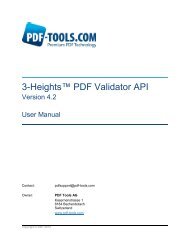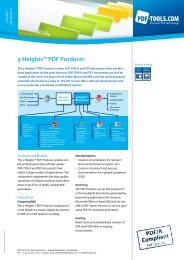Desktop - PDF Tools AG
Desktop - PDF Tools AG
Desktop - PDF Tools AG
You also want an ePaper? Increase the reach of your titles
YUMPU automatically turns print PDFs into web optimized ePapers that Google loves.
3-Heights <strong>PDF</strong> <strong>Desktop</strong> Producer, Version 4.2 Page 23 of 50<br />
July 26, 2013<br />
Execute Program after Creation of <strong>PDF</strong><br />
By checking "Execute Command" (Alt-X) a command can be specified, which is<br />
executed after the file is created. The placeholder %FILE% can be used as a variable of<br />
the file name. This feature can be used for example to launch an application to display<br />
the <strong>PDF</strong> after it is created.<br />
Extended path names must be included in "quotation marks" like for shell commands.<br />
Depending on the command the placeholder may or may not require quotation marks:<br />
"%FILE%". Here are some sample commands:<br />
"C:\<strong>PDF</strong> <strong>Tools</strong>\bin\ViewerPro.exe" "%FILE%"<br />
"C:\Program Files\Adobe\Acrobat 7.0\Acrobat\Acrobat.exe" "%FILE%"<br />
The command is executed under the account that submitted the print job.<br />
In order to execute different commands for different instance of the 3-Heights <strong>PDF</strong> or<br />
TIFF Producer, multiple ports of the type 3-Heights Port Monitor must be installed<br />
and configured individually.<br />
If this option is active then the specified command line executable has access to<br />
environment variables of the printing user’s session.<br />
In addition to the %FILE% variable the %COPIES% and %COLLATE% variables are<br />
replaced by the corresponding values in the device mode (i.e. printer settings).<br />
The command line may also contain variables from the system environment in the<br />
command. The variable %FILE% is reserved and is automatically replaced by an empty<br />
string. The same applies to invalid variables. (System Variables can be listed using the<br />
command ‘set’ in the command prompt.)<br />
Example, assuming %VIEWERPATH% is defined (e.g. as “C:\Program Files\<strong>PDF</strong><br />
Viewer”):<br />
"%VIEWERPATH%\viewer.exe" "%FILE%"<br />
Execute a Script<br />
The command can only start processes. In order to start a batch script (.bat, .cmd) the<br />
executable cmd.exe needs to be started with the batch file as parameter.<br />
Example for an Execute Command:<br />
C:\Windows\system32\cmd.exe /c start C:\run.bat "%FILE%"<br />
And the content of the referred batch file C:\run.bat<br />
"C:\Program Files\<strong>PDF</strong> <strong>Tools</strong> <strong>AG</strong>\bin\viewer.exe" %1<br />
exit<br />
If the script resides at a location whose path contains blanks, the path can be set using<br />
/Dpath, where ‘path’ is an existing directory written in quotes.<br />
C:\Windows\system32\cmd.exe /c start /D"C:\sp ace\" run.bat "%FILE%"<br />
<strong>PDF</strong> <strong>Tools</strong> <strong>AG</strong> – Premium <strong>PDF</strong> Technology
















